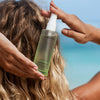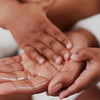Each of us has our own unique skin goals, the checkpoints on our ‘ultimate glow’ mood boards that we’re working towards. With such a diverse range of what we all want from our skin, no two people’s aims are necessarily going to be the same. We know that often deciding where to work backwards from when you’ve got the end of the journey in sight can be an overwhelming prospect. To help out, we thought we’d pull together some of the goals we hear most commonly from our Tropic community and guide you through those first steps on the journey to your dazzling destination. Welcome to Glow Academy...
It is a truth universally acknowledged that a radiant glow is unparalleled in the world of skincare... but sometimes, that glow gets a bit too shiny for its own good. Read on for our tips on how to handle EXCESS OILINESS.
SO, WHAT EXACTLY IS EXCESS OILINESS?
The first thing to note about this is the word ‘excess’. Contrary to popular belief, it’s actually a great thing for your skin not to be completely oil-free. If it was, it would be impossible for our skin’s moisture barrier to be maintained and we’d be facing dryness on the daily. Our bodies all naturally produce an oil known as sebum, which helps to prevent moisture loss and protect our skin from infection – we like to think of it as our skin’s bodyguard. Sometimes however, outside skinfluences cause sebaceous glands to become more cautious and produce more sebum, which leads to extra shine and skin that can feel greasy to the touch.
If this is happening to your skin, you’ll likely notice that it quickly starts to feel oily with a consistent sheen, even after a recent cleanse. As excess sebum starts to merge with dead skin cells in our pores, it increases the chance of clogging which means breakouts aren’t far behind. A sudden emergence of blemishes like pimples or blackheads in one concentrated area can be a strong sign your sebum levels are on the rise.
WHAT CAN HAVE AN IMPACT ON EXCESS OILINESS?

While the route to a glowing blank slate of a complexion, free of unnecessary oils, seems to always start with a cleanser, we actually need to be careful not to overdo things when dealing with a sudden rise in shine. It seems only logical that more oil should mean more cleansing during the day, but we really only need to leave it as a twice-daily part of our morning and evening rituals. Any more, and a domino effect kicks in as we end up completely stripping skin of the bare minimum level of sebum it needs to stay moisturised, upsetting the balance of our moisture barrier further and causing the sebaceous glands to think they have to produce even more oil to overcompensate. It’s a slippery, well-intentioned slope, but leave cleansing for your wake-up and wind-down – unless you’ve really done some intense exercising and want skin to feel fresh!
People are often under the illusion that moisturiser is the natural archnemesis of oiliness, but whether your skin’s in the driest of moods or feeling super shiny, it should be a non-negotiable daily essential. If you miss out on moisturiser, it’s much more likely that the pendulum will swing in the other direction and your oily skin will quickly start to dry out, which yet again makes the sebaceous glands go into overdrive to try and help. When you’re going through a shiny spell, add a lightweight, oil-free moisturiser to your box of beauty tricks that will absorb easily without any unwanted greasiness.
We’re not saying you can eat your way to a completely balanced complexion, but when it comes to avoiding oily skin days, it certainly helps! The areas of the supermarket to steer clear of? High-sugar snacks, dairy products and food high in processed carbohydrates like white rice and white bread have all been linked to an increase in sebum levels.
HOW DO I REDUCE THE APPEARANCE OF EXCESS OILINESS?
- Exfoliation, all the way (well, twice a week, but there’s nothing like a bit of dramatic effect). A gentle exfoliator is just what you need to break down any clogging mixture of dead skin cells and excess sebum that’s built up on your face, allowing layers of shine-causing congestion to be swept away and pores to be cleared out. Maintaining twice-weekly use means you’ve got an extra treat in your routine to look forward to and is also the kinder option for skin, as overuse can actually damage capillaries which sit closely beneath the top layer of your epidermis.
- Play detective with the ingredients in your skincare and avoid products which use harsh sulphates, alcohols and astringents. Even when these say they’re focused on reducing your excess oiliness, they can take things too far and completely remove any moisture that’s left in your upper layers of skin. It’s not too hard to guess what comes next; your barrier function gets thrown off-kilter, your skin dries out and your sebaceous glands start the cycle all over again by producing even more oil.
- While you’re using skincare to target the underlying causes of oiliness, pick up some blotting papers over the counter as a cheap, on-the-go quick fix to mop away the shine in the meantime. Remember – pat, don’t wipe! If you’re wearing makeup, things could very quickly start to look streaky otherwise...
- We’ll stay in the realm of makeup to suggest that if skin takes a turn for the oily, you achieve the perfect matte finish with a mineral powder base instead of a liquid foundation. Liquid options tend to be comedogenic (pore-clogging), but sticking with mineral powders, known for absorbing excess oil, allows you to top up your layers throughout the day while keeping shine under control.
- Time to take a tour of the ideal kitchen cupboards for keeping oily skin at bay! Start out by scouring the supermarket for any natural goodies rich in omega-3, like nuts, flaxseeds and chia seeds, as their fatty acid content offers perfect support to your barrier function. Then it’s zinc’s turn on the menu, found in abundance in red meat, shellfish, legumes and wholegrains. It also happens to be excellent at regulating sebum production!
WHICH INGREDIENTS ARE GOOD FOR EXCESS OILINESS?
Look out for skincare which features...
Hyaluronic acid – Ah, the hydrator supreme! This is the perfect ingredient to help you spot a moisturiser that’s not too heavy, as it effortlessly delivers hydration while remaining incredibly lightweight.
Clay – Sometimes you can’t beat a salt-of-the-earth classic. A more indulgent way to say goodbye to shine, treat yourself to a face mask that uses Kaolin or green clay to absorb any excess oil, mattify skin tone, and refine pores.
Bio-retinol – Retinol itself is frequently associated with inflammation and redness, whereas a plant-derived alternative like bakuchiol lets you experience all of its collagen-boosting, oil-regulating benefits without any of the fuss.
THE EXCESS OILINESS FAQ
Does drinking water help with excess oiliness? When skin is dehydrated, it’s water that your body’s cells are missing out on, not oil. That means it could very well be the case that your skin is simultaneously experiencing an increase in oiliness and dehydration – in fact, dehydration could even be impacting your extra shine. When our cells are low on water, those strong-willed sebaceous glands may decide that they need to up their moisture production to try and overcompensate, and actually all this does is leave you reaching for the blotting papers. Aim to drink at least seven glasses of water a day to remain hydrated and keep skin as balanced as possible.
Why does my nose seem to be more oily than the rest of my face? This will be the case for most people. The sebaceous glands in the nose are naturally some of the largest on your body, so it’s inevitable that you’ll see more oil generated in this area of skin.

 Skincare
Skincare
 Sale
Sale
 Bestsellers
Bestsellers
 Makeup
Makeup
 Body Care
Body Care
 Men's
Men's
 Hair Care
Hair Care
 Mama & Baby
Mama & Baby












